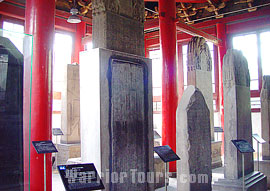- Big Wild Goose Pagoda & Tang Dynasty Palace
- Bell/Drum Tower & Daxingshan Temple
- City Wall
- Forest of Stone Steles Museum & Banpo Museum
- Great Mosque
- Huaqing Hot Springs & Xingjiao Temple
- Mausoleum of the First Qin Emperor
- Mausoleum of Western Han Emperor Liu Qi
- Terracotta Warriors
- Shaanxi History Museum
- Small Wild Goose Pagoda
- Famen Temple & Xianyang Museum
- Maoling Mausoleum & Tomb of Huo Qubing
- Mt. Huashan
- Qian Mausoleum & Zhaoling Mausoleum
Forest of Stone Steles Museum & Banpo Museum

![]() Forest of Stone Steles Museum
Forest of Stone Steles Museum
Situated in Sanxue Street, downtown Xian, the Forest of Stone Steles Museum is a splendid treasury of Chinese art and history. It was originally built in 1078 for the preservation of the 'Kaicheng Stone Classics'. Hundreds of years later, there are almost 3,000 pieces of stone steles in the museum. Altogether six corridors, seven rooms and eight pavilions are used to display these invaluable treasures.
Many steles are very important to historical research. One of the steles, which was carved during the Tang Dynasty (618-907), describes the spread of a branch of Christianity in Chinese and Syriac. Other steles describe the intercourse between Chinese and Nepal, Japan, India and so on. Some steles also record important historic events such as peasants' insurgences and the aggressions of western countries. What's more, many steles in the museum are important records of ancient literatures. The 'Kaicheng Stone Classics', which took seven years to carve, consist of 114 steles with twelve kinds of classics. Roughly 650,252 characters on the steles are considered to be the best preserved of their kind in China. Stone tablets written by famous calligraphers such as Ouyang Xun, Wang Xizhi, Yan Zhenqing and Liu Gongquan also can be found in the museum.
In a word, the Forest of Stone Steles Museum is indeed the best place to know something about Chinese culture and history.
| Admission Fee: |
CNY 75 (Mar. to Nov.)
CNY 50 (Dec. to Feb.)Free for Chinese seniors aged 70 and above with a valid Chinese identity card. |
| Opening Hours: | 08:00 to 18:45 (Summer) 08:00 to 18:00 (Winter) |
| Recommended Time for a Visit: | Three hours |
| Bus Route: |
Bus No. 14, 23, 40, 118, 208, 213, 214, 221, 222, 232, 302, 309, 402, 512, 710, 704, 800, Tourism Bus No. 6, Tourism Bus No. 4 (Through) or Wulong Special Line and get off at Wenchang Gate, and then walk to the museum |

![]() Banpo Museum
Banpo Museum
Banpo museum, the first museum built on the site of historical relics in China, is located in the east suburb of Xian City. It was built in 1957 at the base of the excavation site of Banpo Village. Banpo Village is the site of a typical Neolithic matriarchal community of the Yangshao Culture. The history of it can be dated back 6,000 years. At that time, the Banpo people used tools made of stone to cultivate and colorized pottery as vessels. The Banpo people even began to feed livestock!

The museum consists of two exhibition halls and a site hall. The first exhibition hall mainly shows the tools, vessels and works of art made and used by the Banpo people. Examples include the stone ax, stone knife, stone scoop, millstones, bone needle and knife, pottery basin and pot, and etc. Among them, a bottle with pointed bottom is very striking. It can bail water automatically when it is put into a well. The Banpo people were also impressive in that they also figured out how to use vapor to cook! Images of people and animals painted on the pottery are vivid and delicate, which revealed the culture of Banpo people. The second exhibition hall is used for auxiliary exhibitions about prehistoric cultures, arts, customs, and so on. The site hall preserves the houses, caves, pottery kilns and tombs of the Banpo people. According to the archaeological research, the Banpo people had great techniques of making pottery, and visitors can visit the site of pottery kilns.
The Banpo Matriarchal Clan Village opened in 1994 and shows visitors the life, ceremony, music and dance of the ancient Banpo people. By appreciating or participating in these performances, visitors can better understand the great prehistoric culture.
|
Admission Fee:
|
CNY 35 (Mar. to Nov.)
CNY 25 (Dec. to Feb.) |
|
Opening Hours:
|
08:30 to 17:00
|
|
Recommended Time for a Visit:
|
Four hours
|
|
Bus Route:
|
11, 105
|

